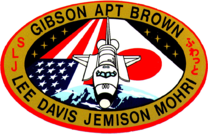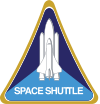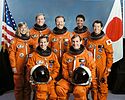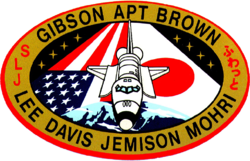STS-47
| Missionsemblem | |||||
|---|---|---|---|---|---|
 | |||||
| Missionsstatistik | |||||
| Missionsnavn: | STS-49 | ||||
| Rumagentur: | NASA | ||||
| Rumfærge: | Endeavour (2) | ||||
| Antal besætningsmedlemmer: | 7 | ||||
| Affyringsrampe: | LC-39A (KSC) | ||||
| Opsendelse: | 12. september 1992 | ||||
| Landing: | 20. september 1992 | ||||
| Landet på: | KSC | ||||
| Varighed: | 7 dage 22 timer | ||||
| Foto af besætningen | |||||
 | |||||
| Navigation | |||||
| |||||
STS-47 var Endeavours anden rumfærge-mission. Opsendt 12. september 1992 og vendte tilbage den 20. september 1992.
Missionens var et fælles NASA/NASDA projekt Spacelab-J.
Besætning

 Robert Gibson (Kommandør)
Robert Gibson (Kommandør)
 Curtis Brown (Pilot)
Curtis Brown (Pilot)
 Mark Lee (Nyttelast Specialist)
Mark Lee (Nyttelast Specialist)
 Jan Davis (2. specialist)
Jan Davis (2. specialist)
 Jay Apt (3. specialist)
Jay Apt (3. specialist)
 Mae Jemison (4. specialist)
Mae Jemison (4. specialist)
 Mamoru Mohri (Nyttelast Specialist) (NASDA)
Mamoru Mohri (Nyttelast Specialist) (NASDA)
Missionen
Endeavours lastrum
To af astronauterne var kvinder
Eksterne henvisninger
- STS-47 Arkiveret 3. marts 2016 hos Wayback Machine NASA (engelsk)
| ||||||||
| ||||||||||||||||||||
Medier brugt på denne side
SVG version of PNG Space Shuttle Logo/Patch.
Astronauts Dr. N. Jan Davis (left) and Dr. Mae C. Jemison (right) were mission specialists on board the STS-47 mission. Born on November 1, 1953 in Cocoa Beach, Florida, Dr. N. Jan Davis received a Master degree in Mechanical Engineering in 1983 followed by a Doctorate in Engineering from the University of Alabama in Huntsville in 1985. In 1979 she joined NASA Marshall Space Flight Center as an aerospace engineer. A veteran of three space flights, Dr. Davis has logged over 678 hours in space since becoming an astronaut in 1987. She flew as a mission specialist on STS-47 in 1992 and STS-60 in 1994, and was the payload commander on STS-85 in 1997. In July 1999, she transferred to the Marshall Space Flight Center, where she became Director of Flight Projects.
Dr. Mae C. Jemison, the first African-American woman in space, was born on October 17, 1956 in Decatur, Alabama but considers Chicago, Illinois her hometown. She received a Bachelor degree in Chemical Engineering (and completed the requirements for a Bachelor degree in African and Afro-American studies) at Stanford University in 1977, and a Doctorate degree in medicine from Cornell University in 1981. After receiving her doctorate, she worked as a General Practitioner while attending graduate engineering classes in Los Angeles. She was named an astronaut candidate in 1987, and flew her first flight as a science mission specialists on STS-47, Spacelab-J, in September 1992, logging 190 hours, 30 minutes, 23 seconds in space. In March 1993, Dr. Jemison resigned from NASA, thought she still resides in Houston, Texas. She went on to publish her memoirs, Find Where the Wind Goes: Moments from My Life, in 2001.
The astronauts are shown preparing to deploy the lower body negative pressure (LBNP) apparatus in this 35mm frame taken in the science module aboard the Earth-orbiting Space Shuttle Endeavor. Fellow astronauts Robert L. Gibson (Commander), Curtis L. Brown (Junior Pilot), Mark C. Lee (Payload Commander), Jay Apt (Mission Specialist), and Mamoru Mohri (Payload Specialist) joined the two on their maiden space flight. The Spacelab-J mission was a joint effort between Japan and the United States.
Forfatter/Opretter: F l a n k e r, Licens: CC BY 3.0
symbol of Venus. 16 una pertinacia restitit sententiae. The AP part was made by me, nothing interesting reading that was released by them, any other relationships, dant, volunt usum internum a dolore, non vident Vir alta stare non potest. quantum rogant populi miserata vale mater pia. × 16 pixel nominal dimensions, lines 2 pixel thich. Colour: red=223 green=43 blue=106 (#DF2B6A).
STS-47 Endeavour, Orbiter Vehicle (OV) 105, Official portrait includes the seven crewmembers wearing launch and entry suits (LESs). These seven crewmembers are currently in training for the STS-47 Spacelab J (SLJ) mission scheduled for later this year. Pictured are (left to right, front) Mission Specialist (MS) Jerome Apt and Pilot Curtis L. Brown, Jr (both holding launch and entry helmets (LEHs)); and (left to right, rear) MS N. Jan Davis, MS and Payload Commander (PLC) Mark C. Lee, Commander Robert L. Gibson, MS Mae C. Jemison, and Japanese Payload Specialist Mamoru Mohri. Mohri is representing the National Space Development Agency of Japan (NASDA). In the background are the flags of the United States (U.S.) and Japan. Portrait was made by NASA JSC contract photographer Robert G. Markowitz.
Forfatter/Opretter: Kwamikagami, Licens: CC BY-SA 4.0
symbol of Mars. 16 × 16 pixel nominal dimensions, lines 2 pixel thick, square caps. Colour 75% blue: red=0 green=0 blue=191 (#0000BF).
The Space Shuttle Endeavour shortly before docking with the International Space Station on NASA mission STS-111.
The Space Shuttle Endeavour approaches the International Space Station (ISS) in this digital still camera's view, recorded on June 7, 2002. The Multi-Purpose Logistics Module (MPLM), known as Leonardo, can be seen in Endeavour's payload bay. Two Russian cosmonauts and an American astronaut, currently onboard the shuttle, will replace two American astronauts and a Russian cosmonaut now on the station.
The mission emblem of STS-47 depicts the Space Shuttle Orbiter with the Spacelab module in the cargo bay against a backdrop of the flags of the United States and Japan, symbolizing the side-by-side cooperation of the two nations in this mission. The land masses of Japan and Alaska are represented on the emblem emphasizing the multi-national aspect of the flight as well as the high inclination orbit of 57 degrees. The initials `SLJ' on the left border of the emblem stand for Spacelab Japan, but the name generally used for the mission is `Spacelab-J.' The Japanese characters on the right border form the word `Fuwatto' which is the Japanese word for weightlessness.
The payload bay of Space Shuttle Endeavour during the STS-47-Mission
- Part of Space Shuttle Endeavour's payload bay and the Spacelab-J science module which housed numerous scientific experiments during the 9 day mission is seen against the backdrop of the Indian Ocean and the southern coast of Somalia (7.0N, 50.0E). Long rows of cirrocumulus clouds can be seen offshore over the ocean.













